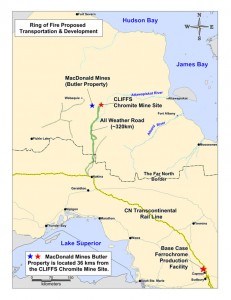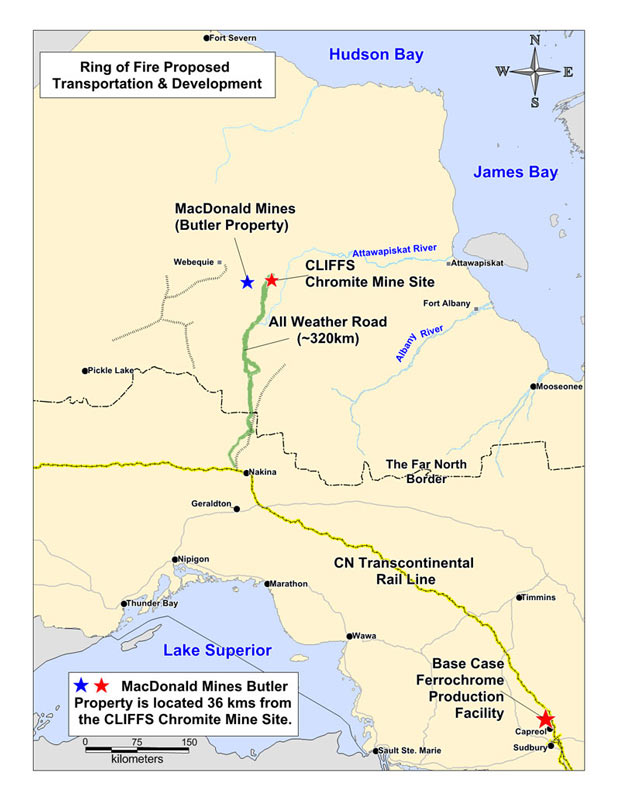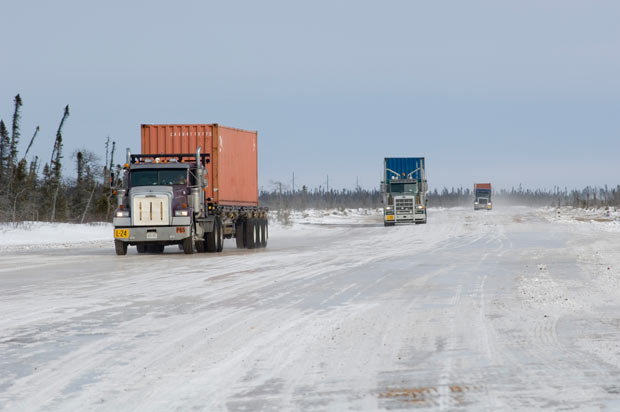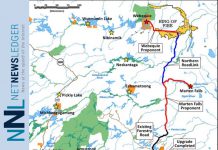
THUNDER BAY – Mining – Ring of Fire Exploration continues. MacDonald Mines Exploration has commenced its Winter 2013 drill program on the Butler 3 volcanogenic massive sulfide (VMS) target in the Ring of Fire (ROF). The newly delineated drill target exhibits coincident geochemical, density, conductivity and chargeability anomalies.
The Butler property is located 36 kilometres west of Cliffs Natural Resources Big Daddy Chromite deposit.
Ring of Fire Chromite Exploration
This area of James Bay presents a unique opportunity in that the Ring of Fire contains the entire suite of minerals including VMS, nickel, chrome, vanadium, titanium and gold potential. The only other similar region is in the Bushveld in South Africa but this region lacks the copper, zinc and nickel content of James Bay.
Analogy to Kidd Creek Deposit: The Butler 3 geophysical anomaly (density, IP and EM) measures 100 metres wide by 500 metres long and is located east of the previously identified stringer mineralization. Last year’s drill hole BP12-Cu11 intersected hydrothermal talc above this anomaly – interpreted as the top of a large, overturned (~90°) VMS feeder system spanning over 1.5 kilometres in length. The Butler 3 geochemical signature and alteration zone are remarkably similar in size and alteration intensity to that observed at Kidd Creek Mine – one of the world’s largest Cu-Zn VMS deposits.
It has been postulated that a Kidd Creek type deposit is possible in the ROF due to the high temperature magma chambers in the footwall of the VMS deposits here. The presence of komatiites, icelandite, talc and tin at Butler 3 is proof that we have a high temperature exhalative system capable of forming large VMS deposit(s).
The Importance Komatiites
The confluence of the prominent markers for high heat flow (komatiites and icelandites), combined with the abundance of highly altered felsic volcanic rocks (rhyolite) all point to this being a highly prospective area. Generally the larger the alteration system, the larger the associated VMS deposit(s).
According to Dr. Larry Hulbert, P.Geo., the only identification of unequivocal komatiites within the ROF are on the Butler Lake property. This has demonstrated to the Company that the property has the potential to host significant mineralization due to the extreme temperatures and potential length of time for a VMS system to form. The only large VMS deposit with a komatiitic suite overlain by rhyolites (as present on the Butler 3 target) is the Kidd Creek deposit in Ontario.
Butler 1, 2 and 4
At the adjacent Butler 4 property, a DPEM geophysical survey (Crone Geophysics) is being completed, after which drill targets will be selected. The Butler 1, 2 and 4 occurrences all share the same stratigraphic assemblage and analogous geology as Butler 3, a characteristic of most of the producing VMS camps in the Canadian Shield.






